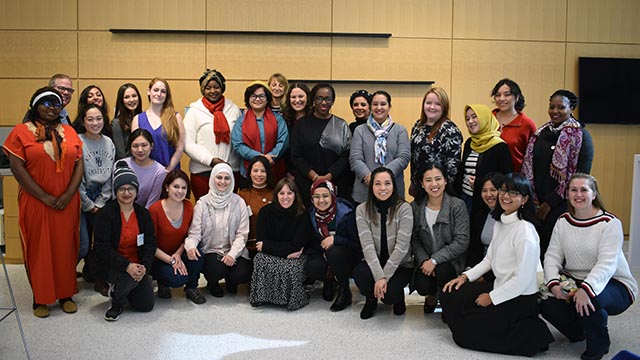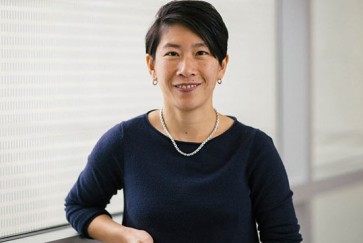Omolola Salako joined the U.S. Department of State’s International Visitor Leadership Program for the promise of “aha moments” — inspiring experiences that would enable her to better serve the patients she treats as an oncologist in Nigeria.
She had one of those moments Nov. 8 at Northwestern University.
Salako was one of 23 women — each from a different country — who visited the Simpson Querrey Biomedical Research Center (SQBRC) as part of a program titled “Hidden No More: Empowering Women Leaders in STEM.” The visitors represented six different continents and ran the gamut of STEM professions, from physicians to researchers to educators.
At the SQBRC, they learned from scientists in the Simpson Querrey Institute’s Center for Bio-Integrated Electronics (CBIE) about technologies that integrate seamlessly with the human body to monitor clinically relevant information, including vital signs for newborns, skin hydration, UV exposure and sweat biomarkers.
It’s really cool to see so many global leaders in STEM come together for this event, which you normally don’t see day to day. It was a rare opportunity to present my research to such a diverse group.”
graduate student
Tony Banks, director of research at CBIE, said several of the women commented about the interdisciplinary nature of the research, something they hadn’t been exposed to in their countries. Salako was in this group and said her head was still spinning with the possibilities of collaborating with engineers to produce meaningful technologies for medical monitoring and treatment. She said devices such as the ones developed at CBIE could offer important information about how her cancer patients are responding to therapies, and she believes she personally could have benefited from the skin hydration sensors because it took her years to find a product that successfully addressed her dry skin.
“I’m basically awed by the way they’re thinking,” she said. “They are tackling everyday problems.”
Katerine Orbe, a biologist with Ecuador’s National Agriculture Research Institute, was particularly interested in the presentation on thumbnail-sized UV sensors. She lives in the capital city of Quito, where the elevation of over 9,000 feet increases the risks of sun damage and skin cancer.
“It is amazing that you can take some little (device) on your clothes, and you can know exactly what’s happening using this kind of sensor,” she said.
The visit from these international leaders also offered a unique opportunity for student researchers in CBIE, which is directed by John A. Rogers. Five young women — Surabhi Madhvapathy, Andrea Carlini, Simone Heo, Jean Kwak and Olivia Prado — showcased their work as part of a group doing its part to promote women in STEM; nine of the 15 current Ph.D. candidates in the Rogers lab are women.
“It’s really cool to see so many global leaders in STEM come together for this event, which you normally don’t see day to day,” said Madhvapathy, a graduate student who presented the work on sensors to measure skin hydration health. “It was a rare opportunity to present my research to such a diverse group.”
The “Hidden No More” program was arranged by the Institute of International Education and is named after the 2016 film “Hidden Figures,” which documented the story of three black female mathematicians who worked at NASA during the space race. The entire program includes 50 women from 50 countries and lasts through Nov. 15. Each visitor was scheduled to tour four U.S. cities; about half of the group was in Boston while the 23 women visited Northwestern and the SQBRC. WorldChicago helped arrange the Chicago portion of the program.
I’m going back to Nigeria really excited at the possibilities that I can sort of ‘wake up’ again.”
participant
Salako said “Hidden No More” has provided a platform for these scientific leaders to share their stories and learn from each other. She added that her time at Northwestern was “enlightening,” as it was the first time she had visited a biomedical engineering facility. It won’t be the last.
“It’s been so far two weeks full of discovery, wanting to do more good, wanting to make a change,” Salako said. “I’m going back to Nigeria really excited at the possibilities that I can sort of ‘wake up’ again.
“One thing that I’m going to do for sure is go into some of our biomedical institutions and just raise awareness, so I can understand what’s going on and see if I can link it to my work in oncology.”
— Daniel Allar


